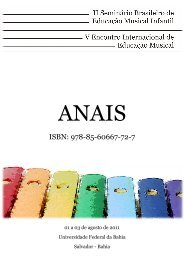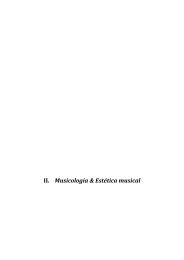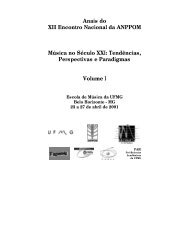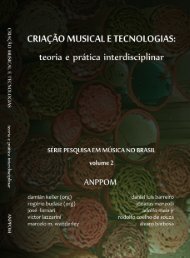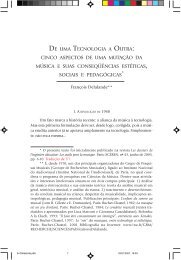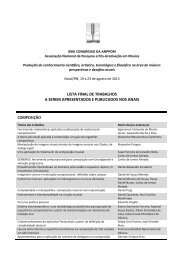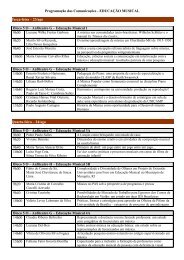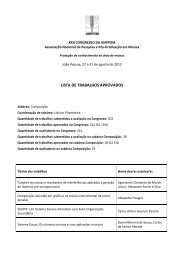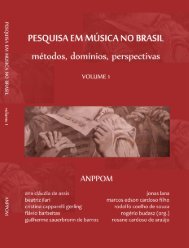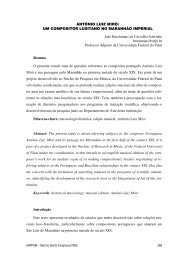download da versão impressa completa em pdf - anppom
download da versão impressa completa em pdf - anppom
download da versão impressa completa em pdf - anppom
Create successful ePaper yourself
Turn your PDF publications into a flip-book with our unique Google optimized e-Paper software.
54<br />
ASPECTOS DE TRANSFORMAÇÃO TEMÁTICA NO<br />
“NOTURNO” PARA O III ATO DE CONDOR DE<br />
CARLOS GOMES<br />
Marcos Pupo Nogueira<br />
Resumo: O trabalho analisa a estrutura t<strong>em</strong>ática do prelúdio sinfônico que Carlos Gomes escreveu<br />
para o terceiro e último ato, o “Noturno”, <strong>da</strong> ópera “Côndor”. Aponta a tendência do compositor<br />
para uma escrita que integra os t<strong>em</strong>as por meio de transformações de motivos básicos, algo<br />
também presente <strong>em</strong> outras peças orquestrais de suas óperas. A peça <strong>em</strong> questão, <strong>em</strong>bora<br />
breve, se aproxima de um tipo de sinfonismo europeu do final do século XIX, no qual a escrita<br />
t<strong>em</strong>ática é bastante coesa. Gomes, além disso, se afasta de um sinfonismo muito atrelado à mera<br />
vocali<strong>da</strong>de e ao cantabile característicos <strong>da</strong> ópera italiana do final do século XIX.<br />
Palavras chave: Motivos básicos. Ópera. Prelúdio Sinfônico<br />
Abstract: The work analyzes the th<strong>em</strong>atic structure of the symphonic prelude that Carlos Gomes<br />
wrote for the third and last act, the “Noturno”, of his opera “Côndor”. It points the trend of the<br />
composer with respect to a writing that integrates the subjects by means of transformations of a<br />
basic motif, something also present in other orchestra´s parts of its operas. This prelude, even a<br />
little piece, is near to a type of European symphonism of the end of century XIX, in which the<br />
th<strong>em</strong>atic writing is very cohesive. Gomes, moreover, moves away from a very joined symphonism<br />
to the mere characteristic vocalism and cantabile of the Italian opera of the end of century XIX.<br />
Keywords: Basic motives. Opera. Sinfonic prelude.<br />
O conceito principal que permite e fun<strong>da</strong>menta o eixo central deste<br />
trabalho - resultante <strong>da</strong> minha tese de doutorado “Carlos Gomes,<br />
Um Compositor Orquestral”, dedica<strong>da</strong> a estudo t<strong>em</strong>ático e sinfônico<br />
<strong>da</strong>s formas orquestrais <strong>da</strong>s óperas do compositor campineiro - ou<br />
seja, a análise e significado <strong>da</strong> escrita t<strong>em</strong>ática e sinfônica no<br />
“Noturno” para o terceiro ato <strong>da</strong> última ópera de Carlos Gomes, se<br />
forma a partir dos estudos <strong>em</strong>preendidos por Arnold Schoenberg,<br />
“Fun<strong>da</strong>mentals of Musical Composition”, e Rudolf Reti, “Th<strong>em</strong>atic<br />
Process in Music”, sobre a construção t<strong>em</strong>ática na música européia<br />
dos séculos XVIII e XIX. Os dois, ca<strong>da</strong> um a seu modo, se<br />
concentraram <strong>em</strong> uma estética que consideraram central na música<br />
do período clássico, romântico e pós-romântico, e estiveram<br />
ocupados <strong>em</strong> explicitá-la, principalmente nas obras cita<strong>da</strong>s. Essa<br />
tendência se refere exatamente a obras nas quais o aspecto<br />
Revista Opus 12 - 2006



